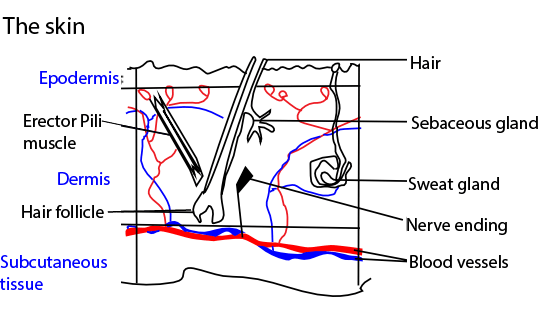
Temperature regulation in animals (A-level)
Dr. Bbosa Science

Why should animals regulate body temperatures?
The body temperature must be kept constant because enzymes work best at specific optimum temperature. For instance, human body temperature is about 36.90C which is the optimum temperature for its enzymes. At high temperature above 400C enzymes are denatured or too low temperatures lead to slowing of metabolic activities and impairing the activities of important organs such as the brain.
Types of temperature regulation.
Animals are grouped into two groups basing on the mechanism of their body temperature regulations
- Homoeothermic or “warm-blooded”, endotherms or endothermic animals maintain body temperature by physiological means. i.e. they generate heat when their body temperature falls and increase the heat loss when their body temperature rises, e.g. mammals e.g. cat and birds.
- Poikilothermic or “cold-blooded”, ectotherms or ectothermic animals have varying body temperature varying with the environment temperature; optimal temperature is maintained by behavior means, i.e. moving to cold places when it is hot or moving to hot places when it is cold. Examples of ectotherms are lizard, snake, frog.
Note: – The blood of ectotherms is not actually cold
– ectotherms regulate their body temperatures by behavioral means
The figure below shows the relationship between body temperature and environmental temperature for a cat (endotherm) and a lizard (ectotherm).

Advantages of being endothermic animals
- Survives in a wide range of environmental temperatures
- Metabolic reactions in the body are always carried out effectively no matter variations in surrounding temperature.
- The response of the organism to stimuli are always quick
- High metabolic activities
Disadvantages of endotherms
- High food consumption to obtain energy
- High demand for insulation in cold condition
Advantage of ectotherms
- Low food consumption since it is not used to maintain body temperature.
- Bodies are less affected by wide environmental temperature variation
Disadvantage of ectotherms
- Low Basal metabolic rates
- Slow response to stimuli
- Limited ecological niches since they cannot survive in extreme temperature changes.
How heat energy is lost or gained by animals.
Organisms lose or gain heat from the environment by four physical processes.
- Conduction is the transfer of heat energy from hotter to the cooler of two objects in contact with each other.
- Radiation is the heat transfer from a hot body to a cool one that are not in contact. It is a major source of heat loss.
- Evaporation is change of a liquid to a vapour, it is accompanied by cooling. This is the cause of cooling accompanied by sweating.
- Convection: is the movement of air resulting from local pockets of warm air being replaced by cooler air, and vice vasa. The air movement speeds up loss of heat by radiation and evaporation.
In addition animals may lose heat through
- Urinating warm urine
- Vomiting
- Spitting
- Defecating

The skin is divided into two main layers, the epidermis at the surface, and the dermis beneath. Below the dermis is another layer, not strictly part of the skin, called the hypodermis.
The epidermis is made up of stratified epithelium. The bottom-most layer of cells, the Malpighian layer, contains variable amounts of black pigments melanin which protects the body from the harmful effects of ultraviolet rays from the sun.
The cells of the Malpighian layer divide repeatedly in a plane horizontal to the surface of the body. As new cells are formed, the older ones get pushed outwards towards the surface, flattening as they do so. After a time, the cytoplasm becomes converted into scales of Keratin, giving rise to the Keratinised layer at the surface of the epidermis. The keratinized layer protects the skin from damage and makes it waterproof.
Oil is secreted on to the surface of the epidermis by sebaceous glands makes the hair supple and enhances the skin’s waterproofing properties.
The roots of the hair are embedded in the dermis or hypodermis. Running from the side of each hair follicle to the base of the epidermis is erector pili muscle. When this muscle contracts, the hair is pulled into a more vertical position. In this position hair trap, a layer of air around the skin thereby insulating the skin from heat loss.
The dermis contains sweat glands that secrete a salty solution, sweat. The sweat passes down the sweat ducts to the surface of the epidermis, and its subsequent evaporation cools the skin and blood flowing through it.
The hypodermis contains a variable amount of fat (subcutaneous fat) which insulates and prevents heat loss from the body.
The response of endotherms e.g. man to cold conditions
- The hair is raised and brought into a more-or-less vertical position by contraction of erector pili muscle. Air gets trapped in the spaces between the hairs and being a poor conductor of heat, it serves as an insulator around the animals. In humans the body hair is much reduced, it’s placed being taken by clothes. Still, the erector pili muscles contract just the same, resulting in “goose pimple”. In birds the feathers serve the same function as the hair of mammals, being raised in cold weather.
- Vasoconstriction: i.e. the arterioles leading to the superficial capillaries constrict. As a result, the blood flow to the surface of the skin is reduced, thereby cutting down the heat energy from the blood to the surrounding.
- The metabolic rate increases, the generation of heat inside the body to compensate for heat loss.
- The decrease in sweating reduces heat loss through evaporation.
- Shivering: at very low-temperature skeletal muscles are stimulated to contract and relax automatically leading to production of heat.
The response of endotherms by Behavioral mechanism
- Engaging in exercises (making a lot of noise in some organism)
- Taking hot drinks or bath
- Wearing heavy clothes
- Burrowing
- Hibernation
Response of endotherms to hot conditions.
- The hairs are lowered: by relaxation of erector pili muscles, so they lie flat against the surface of the skin, less air is trapped between the hairs, insulation is therefore reduced, and heat energy can be lost more readily by conduction, radiation and convection.
- The arterioles leading to the superficial capillaries dilate. As a result, the blood flow to the surface is increased and more heat energy can be lost to the surrounding.
- Sweating or panting occur, and evaporation of water from the moist skin or tongue cools the blood as it flows through the superficial capillaries. As a means of cooling the human body, sweating is extremely important. In dogs and cats sweating is substituted with panting.
- The metabolic rate decreases, reducing heat energy generated in the body.
Adaptations of endotherms to the cold environment.
- The animals develop large volume to surface ratio. i.e. the extremities such as ear tend to be small and the animals tend to be larger.
- Animals in cold environments have thicker subcutaneous fat.
- Animals in cold environments tend to have heavy fur or hairs.
- Animals in cold environment develop high metabolic rates.
- Reduced extremities to reduce the surface area for heat loss.
- Animals in cold environments develop arteries and veins in close proximity, such that as blood flows down the arteries, heat energy passes from it to the much cooler blood which is returning in the opposite direction in the veins. The counter-current heat exchange system is seen in flippers of dolphins and the legs of ducks, both of which highly happen to be in cold water. It achieves two things. First, it means that the arterial blood has already been cooled by the time it reaches the end of the limb so that relatively little heat energy is lost to the surrounding. Secondly, it warms the venous blood before it gets back to the main part of the body.
Adaptations of endotherms to Hot environment.
- Have thin subcutaneous fat layer to promote heat loss
- Are small compared to their counterpart in cold regions to provide big surface area to volume ratio
- Have large extremities to increase the surface area for heat loss.
- They have many sweat glands to produce sweat whose evaporation cools the body
- Have less fur
Behavioral control of body temperature by ectotherms
Many ectoderms respond to high environmental temperature by
- Moving to cool places
- Thermal gaping
- Aestivation
- Migration to cooler places
Ectoderms respond to cool environment temperatures by
- Moving to warm place
- Basking
- Sleeping in piles to reduce heat loss
- Burrowing
Adaptations of animals to live in cold environments
- Hibernating is a behavioral response by many temperate and artic animals to very cold temperatures. The animal responds to a very cold temperature by going into a deep sleep. The metabolic rate falls to the minimum required to keep life ticking over. The body temperature also falls, and is maintained at a much lower level than normal. Hibernation saves these animals from expending large heat energy in winter whilst the food is scarce surviving extremes of temperatures.
- By supercooling: Supercooling is the lowering of the temperature of a fluid to below its freezing point without the formation of ice. Ice crystals can damage tissues and supercooling provides a way of avoiding this. Experiments have shown that certain reptiles can be supercooled to as low as -80C without freezing. Plants and fishes also go in for supercooling.
- By freezing tolerance. Some organisms, notably plants and insects can tolerate the formation of ice in their tissues. Certain insects’ larvae can recover after as much as 90% of the body has been frozen. In these organism’s ice crystals form between, rather than inside the cells; later when the ice melts. In some species of fish ice damage is lessened by the presence of glycerol in the tissues. Glycerol is used in human blood banks and sperm banks to prevent injury to the cells when they are frozen for storage.
- By using an antifreeze: some fish employ anti-freeze such as glycerol and glycoproteins to lowers the freezing point so that the body fluids do not freeze in winter.
Adaptation of organisms to high temperature
The main adaptation here is tolerance. This enables certain types of algae to flourish in hot springs at temperatures of 55 to 600C. However, it is prokaryotes that show the greatest tolerance. There are many reports of bacteria growing in boiling hot springs to North America and New Zealand, but the jackpot must go to certain bacteria that have been discovered in the hot water rising from sulphate encrusted vents in the deep ocean floor. Some of these bacteria were living at temperatures of 3500C. It is claimed that in the laboratory they reproduced enthusiastically in seawater at 2500C, doubling in number every 40 minutes. Heat tolerant bacteria possess membranes which are more heat stable than those of other prokaryotes, and their enzymes work optimally at temperatures well above those that would denature the enzymes of other organism. e.g. Thermophilus, a bacteria which lives in hot springs, possesses enzymes that work best at 800C.
The brain and temperature regulation
The thermoregulation center in the brain is found in the hypothalamus. Hypothalamus is sensitive to the temperature of blood flowing through it and responds by sending nerve impulses to the appropriate effectors. If the temperature of the blood is higher than normal, the thermos regulatory center detects this and sets into motion the various processes that cool the body and vice versa.
The upper and lower critical temperature of the body

The lower critical temperature.
The lower critical temperature is the environment temperature below which physical mechanism such as insulation cannot maintain body temperature. The lower critical temperatures are lower for arctic mammals (e.g. Eskimo dog, white fox) than for tropical mammals such as man because arctic mammals have better insulation.
The lower critical temperature for arctic mammal is about -400C while that of man is 270C. When the animal is cooled below the lower critical temperature, the basal metabolic rate increases to maintain the body temperature until the temperature reaches the lower lethal temperature below which the organism dies for failure to maintain body temperature.
Arctic mammals have lower critical and lethal temperature due to a big layer of subcutaneous fats and thick fur for insulation; they have small extremities and their arteries and veins from extremities are close to each other to reduce heat loss.
The upper critical temperature.
The upper critical temperature (290C for man) is the environment temperature above which physical mechanisms such as sweating, lowering hair cannot maintain body temperature. The upper critical temperatures are lower for arctic mammals (e.g. Eskimo dog, white fox) than for tropical mammals such as man
When the environmental temperature rises above the upper critical temperature, the basal metabolic rate increases due to increase in body temperature and enzymatic controlled reaction up to the upper lethal temperature above which enzymes are denatured and the organism dies.
Desert animal have higher critical and lethal temperatures than arctic animals because they have low-fat deposits and less hair to insulate the body
Temperature control in plants
- Transpiration lowers escalating temperature.
- Shiny cuticles reflect heat radiated by the sun.
- Having small leaves reduces surface area for heat absorption.
For revision, questions download PDF below
Please find free downloadable notes, exams and marking guides of agriculture, biology, Physics, chemistry etc. from digitalteachers.co.ug website.
Dr. Bbosa Science

Good work
Thanks for sharing your wisdom. Office Products
You always bring something new to the table. Indian Cricket
Secure admission to renowned colleges with MBBS Direct Admission in Punjab, ensuring a seamless experience.
Discover simplified enrollment opportunities with MBBS Admission Through Management/Nri Quota in Delhi.
Invite your friends and enjoy bonuses with the Raja Luck Invite Code.
This is an eye-opener for me. I had no idea how crucial a Backlink Strategy was!
Increase your rankings with High-quality backlinks from reliable sources.
Get exclusive insights into battery advancements, charging infrastructure, and EV policies in EV News.
Support high-end business applications with effective Server Rental in Hyderabad.